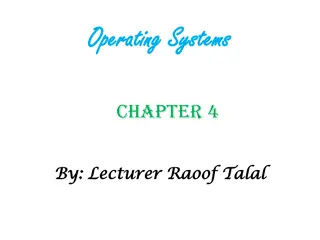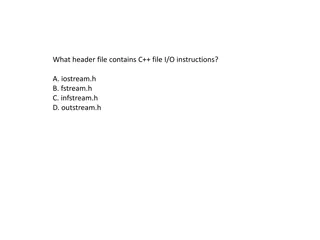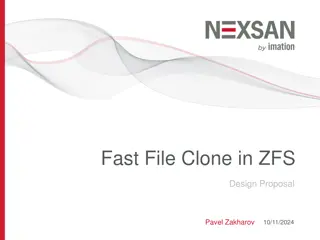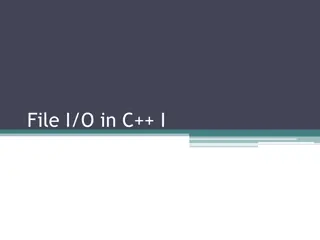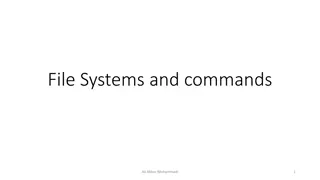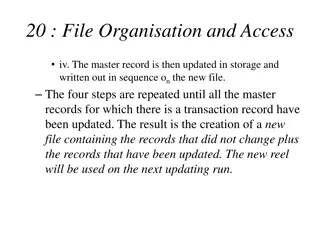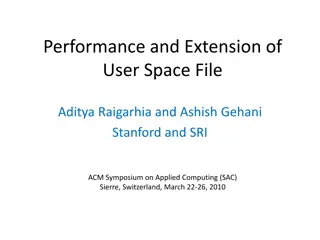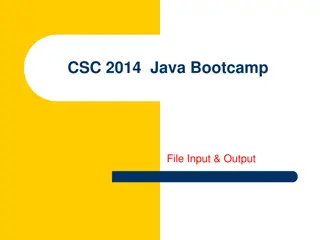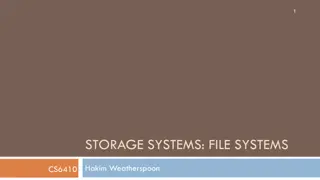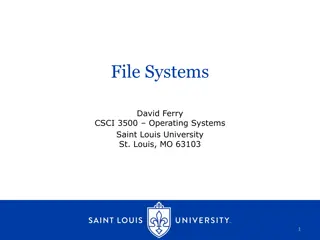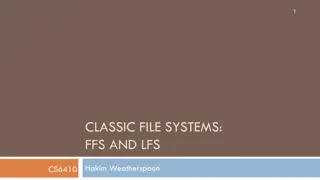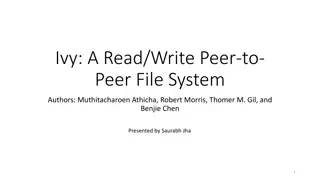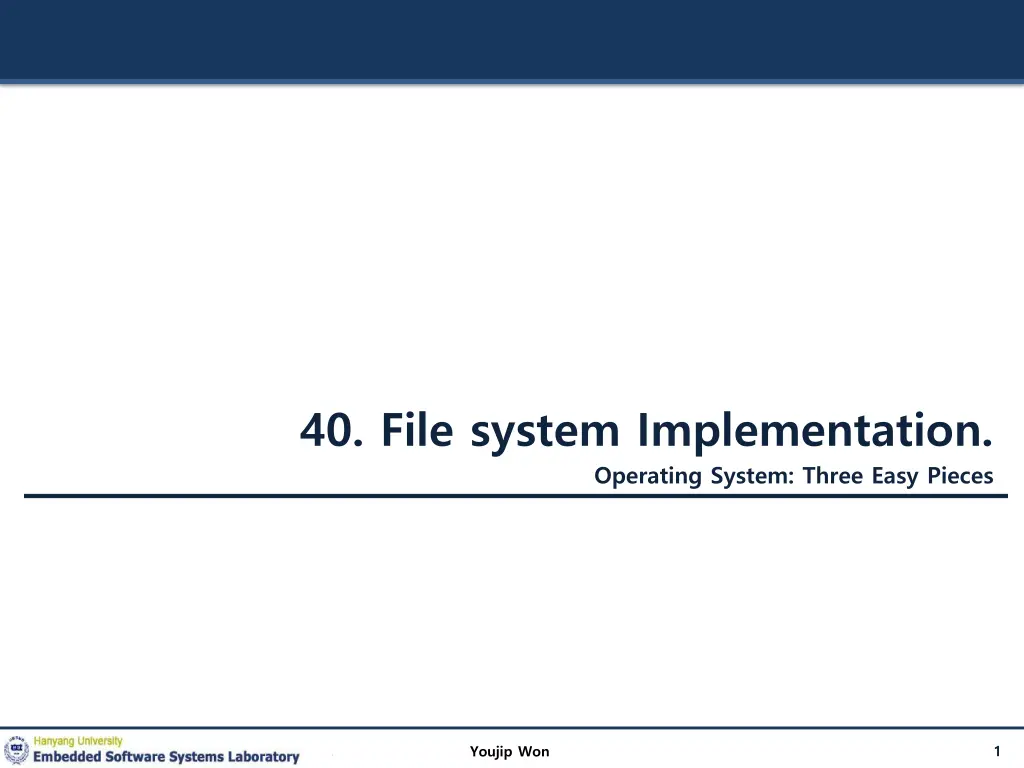
In-depth Exploration of File System Implementation and Organization
Discover the intricate details of implementing a file system, including on-disk structures, access methods, overall organization, data storage, inode management, and allocation structures. Dive into the fundamentals of file system design and how it tracks data blocks and inodes, all crucial for efficient data storage and management.
Download Presentation

Please find below an Image/Link to download the presentation.
The content on the website is provided AS IS for your information and personal use only. It may not be sold, licensed, or shared on other websites without obtaining consent from the author. If you encounter any issues during the download, it is possible that the publisher has removed the file from their server.
You are allowed to download the files provided on this website for personal or commercial use, subject to the condition that they are used lawfully. All files are the property of their respective owners.
The content on the website is provided AS IS for your information and personal use only. It may not be sold, licensed, or shared on other websites without obtaining consent from the author.
E N D
Presentation Transcript
40. File system Implementation. Operating System: Three Easy Pieces 1 Youjip Won
The Way To Think There are two different aspects to implement file system Data structures What types of on-disk structures are utilized by the file system to organize its data and metadata? Access methods How does it map the calls made by a process as open(), read(), write(), etc. Which structures are read during the execution of a particular system call? 2 Youjip Won
Overall Organization Let s develop the overall organization of the file system data structure. Divide the disk into blocks. Block size is 4 KB. The blocks are addressed from 0 to N -1. 0 7 8 15 16 23 24 31 32 39 40 47 48 55 56 63 3 Youjip Won
Data region in file system Reserve data region to store user data Data Region D D D D D D D D D D D D D D D D D D D D D D D D 0 7 8 15 16 23 24 31 Data Region D D D D D D D D D D D D D D D D D D D D D D D D D D D D D D D D 32 39 40 47 48 55 56 63 File system has to track which data block comprise a file, the size of the file, its owner, etc. How we store these inodes in file system? 4 Youjip Won
Inode table in file system Reserve some space for inode table This holds an array of on-disk inodes. Ex) inode tables : 3 ~ 7, inode size : 256 bytes 4-KB block can hold 16 inodes. The filesystem contains 80 inodes. (maximum number of files) Inodes Data Region i d I I I I I D D D D D D D D D D D D D D D D D D D D D D D D 0 7 8 15 16 23 24 31 Data Region D D D D D D D D D D D D D D D D D D D D D D D D D D D D D D D D 32 39 40 47 48 55 56 63 5 Youjip Won
allocation structures This is to track whether inodes or data blocks are free or allocated. Use bitmap, each bit indicates free(0) or in-use(1) data bitmap: for data region for data region inode bitmap: for inode table Inodes Data Region i d I I I I I D D D D D D D D D D D D D D D D D D D D D D D D 0 7 8 15 16 23 24 31 Data Region D D D D D D D D D D D D D D D D D D D D D D D D D D D D D D D D 32 39 40 47 48 55 56 63 6 Youjip Won
Superblock Super block contains this information for particular file system Ex) The number of inodes, begin location of inode table. etc Inodes Data Region S i d I I I I I D D D D D D D D D D D D D D D D D D D D D D D D 0 7 8 15 16 23 24 31 Data Region D D D D D D D D D D D D D D D D D D D D D D D D D D D D D D D D 32 39 40 47 48 55 56 63 Thus, when mounting a file system, OS will read the superblock first, to initialize various information. 7 Youjip Won
File Organization: The inode Each inode is referred to by inode number. by inode number, File system calculate where the inode is on the disk. Ex) inode number: 32 Calculate the offset into the inode region (32 x sizeof(inode) (256 bytes) = 8192 Add start address of the inode table(12 KB) + inode region(8 KB) = 20 KB The Inode table iblock 0 iblock 1 iblock 2 iblock 3 iblock 4 0 1 2 3 16 17 18 19 32 33 34 35 48 49 50 51 64 65 66 67 4 5 6 7 20 21 22 23 36 37 38 39 52 53 54 55 68 69 70 71 Super i-bmap d-bmap 8 9 10 11 24 25 26 27 40 41 42 43 56 57 58 59 72 73 74 75 12 13 14 15 28 29 30 31 44 45 46 47 60 61 62 63 76 77 78 79 0KB 4KB 8KB 12KB 16KB 20KB 24KB 28KB 32KB 8 Youjip Won
File Organization: The inode (Cont.) Disk are not byte addressable, sector addressable. Disk consist of a large number of addressable sectors, (512 bytes) Ex) Fetch the block of inode (inode number: 32) Sector address iaddr of the inode block: blk : (inumber * sizeof(inode)) / blocksize sector : (blk * blocksize) + inodeStratAddr ) /sectorsize The Inode table iblock 0 iblock 1 iblock 2 iblock 3 iblock 4 0 1 2 3 16 17 18 19 32 33 34 35 48 49 50 51 64 65 66 67 4 5 6 7 20 21 22 23 36 37 38 39 52 53 54 55 68 69 70 71 Super i-bmap d-bmap 8 9 10 11 24 25 26 27 40 41 42 43 56 57 58 59 72 73 74 75 12 13 14 15 28 29 30 31 44 45 46 47 60 61 62 63 76 77 78 79 0KB 4KB 8KB 12KB 16KB 20KB 24KB 28KB 32KB 9 Youjip Won
File Organization: The inode (Cont.) inode have all of the information about a file File type (regular file, directory, etc.), Size, the number of blocks allocated to it. Protection information(who ones the file, who can access, etc). Time information. Etc. 10 Youjip Won
File Organization: The inode (Cont.) Size 2 2 4 4 4 4 4 4 2 2 4 4 60 4 4 4 4 12 Name mode uid size time ctime mtime dtime gid links_count blocks flags osd1 block generation file_acl dir_acl faddr i_osd2 What is this inode field for? can this file be read/written/executed? who owns this file? how many bytes are in this file? what time was this file last accessed? what time was this file created? what time was this file last modified? what time was this inode deleted? which group does this file belong to? how many hard links are there to this file? how many blocks have been allocated to this file? how should ext2 use this inode? an OS-dependent field a set of disk pointers (15 total) file version (used by NFS) a new permissions model beyond mode bits called access control lists an unsupported field another OS-dependent field The EXT2 Inode 11 Youjip Won
The Multi-Level Index To support bigger files, we use multi-level index. Indirect pointer points to a block that contains more pointers. inode have fixed number of direct pointers (12) and a single indirect pointer. If a file grows large enough, an indirect block is allocated, inode s slot for an indirect pointer is set to point to it. (12 + 1024) x 4 K or 4144 KB 12 Youjip Won
The Multi-Level Index (Cont.) Double indirect pointer points to a block that contains indirect blocks. Allow file to grow with an additional 1024 x 1024 or 1 million 4KB blocks. Triple indirect pointer points to a block that contains double indirect blocks. Multi-Level Index approach to pointing to file blocks. Ex) twelve direct pointers, a single and a double indirect block. over 4GB in size (12+1024+10242) x 4KB Many file system use a multi-level index. Linux EXT2, EXT3, NetApp s WAFL, Unix file system. Linux EXT4 use extents instead of simple pointers. 13 Youjip Won
The Multi-Level Index (Cont.) Most files are small Average file size is growing Most bytes are stored in large files File systems contains lots of files File systems are roughly half full Directories are typically small Roughly 2K is the most common size Almost 200K is the average A few big files use most of the space Almost 100K on average Even as disks grow, file system remain -50% full Many have few entries; most have 20 or fewer File System Measurement Summary 14 Youjip Won
Directory Organization Directory contains a list of (entry name, inode number) pairs. Each directory has two extra files . dot for current directory and .. dot-dot for parent directory For example, dir has three files (foo, bar, foobar) inum | reclen | strlen | name 5 4 2 4 12 4 13 4 24 8 2 . 3 .. 4 foo 4 bar 7 foobar on-disk for dir 15 Youjip Won
Free Space Management File system track which inode and data block are free or not. In order to manage free space, we have two simple bitmaps. When file is newly created, it allocated inode by searching the inode bitmap and update on-disk bitmap. Pre-allocation policy is commonly used for allocate contiguous blocks. 16 Youjip Won
Access Paths: Reading a File From Disk Issue an open( /foo/bar , O_RDONLY), Traverse the pathname and thus locate the desired indoe. Begin at the root of the file system (/) In most Unix file systems, the root inode number is 2 Filesystem reads in the block that contains inode number 2. Look inside of it to find pointer to data blocks (contents of the root). By reading in one or more directory data blocks, It will find foo directory. Traverse recursively the path name until the desired inode ( bar ) Check finale permissions, allocate a file descriptor for this process and returns file descriptor to user. 17 Youjip Won
Access Paths: Reading a File From Disk (Cont.) Issue read() to read from the file. Read in the first block of the file, consulting the inode to find the location of such a block. Update the inode with a new last accessed time. Update in-memory open file table for file descriptor, the file offset. When file is closed: File descriptor should be deallocated, but for now, that is all the file system really needs to do. No dis I/Os take place. 18 Youjip Won
Access Paths: Reading a File From Disk (Cont.) data bitmap inode bitmap root inode foo inode bar inode root data foo data bar bar bar data[0] data[1] data[2] open(bar) read read read read read read read() read write read read() read write read read() read write File Read Timeline (Time Increasing Downward) 19 Youjip Won
Access Paths: Writing to Disk Issue write() to update the file with new contents. File may allocate a block (unless the block is being overwritten). Need to update data block, data bitmap. It generates five I/Os: one to read the data bitmap one to write the bitmap (to reflect its new state to disk) two more to read and then write the inode one to write the actual block itself. To create file, it also allocate space for directory, causing high I/O traffic. 20 Youjip Won
Access Paths: Writing to Disk (Cont.) data bitmap inode bitmap root inode foo inode bar inode root data foo data bar bar bar data[0] data[1] data[2] create (/foo/bar) read read read read read write write read write write write() read read write write write read write() read write write write read write() read write write write File Creation Timeline (Time Increasing Downward) 21 Youjip Won
Caching and Buffering Reading and writing files are expensive, incurring many I/Os. For example, long pathname(/1/2/3/ ./100/file.txt) One to read the inode of the directory and at least one read its data. Literally perform hundreds of reads just to open the file. In order to reduce I/O traffic, file systems aggressively use system memory(DRAM) to cache. Early file system use fixed-size cache to hold popular blocks. Static partitioning of memory can be wasteful; Modem systems use dynamic partitioning approach, unified page cache. Read I/O can be avoided by large cache. 22 Youjip Won
Caching and Buffering (Cont.) Write traffic has to go to disk for persistent, Thus, cache does not reduce write I/Os. File system use write buffering for write performance benefits. delaying writes (file system batch some updates into a smaller set of I/Os). By buffering a number of writes in memory, the file system can then schedule the subsequent I/Os. By avoiding writes Some application force flush data to disk by calling fsync() or direct I/O. 23 Youjip Won
Disclaimer: This lecture slide set was initially developed for Operating System course in Computer Science Dept. at Hanyang University. This lecture slide set is for OSTEP book written by Remzi and Andrea at University of Wisconsin. 24 Youjip Won


